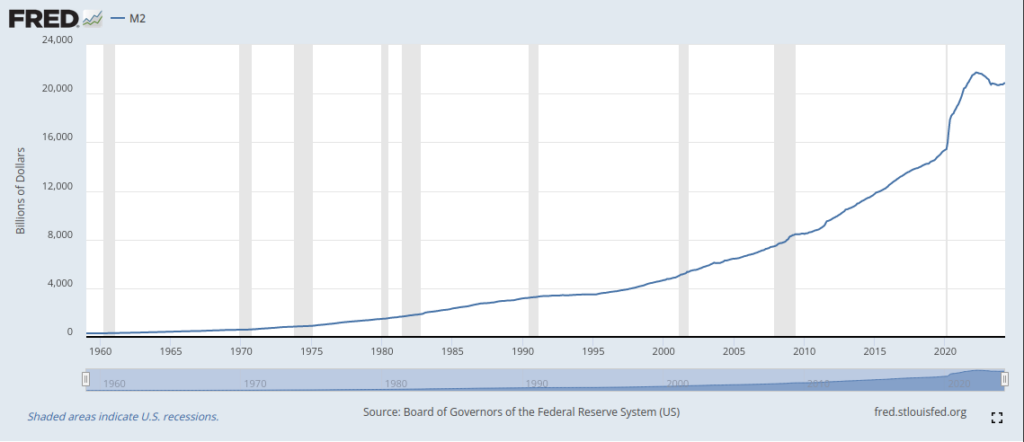A recent phenomenon of our time has been the skyrocketing popularity of memecoins and memestocks among the new generation of investors. What started as a joke between two software engineering students with the creation of the first memecoin, Dogecoin, back in December 2013 has now become a niche of the industry.
In a world where modern monetary policy has driven the main central banks of the world to engage in a money-printing frenzy, which has escalated to new highs since the COVID-19 pandemic, it has had ripple effects across the whole global economy. Waves of high inflation not seen since the 1970’s, coupled with a changing world economy due to the rise of artificial intelligence and robotization, has driven the average person to try to make profit from speculating in financial markets.
The widespread use of smartphones across almost all social economic strata, together with social media, has made it possible for the average person to access the financial markets in ways it was not possible a few decades before. However, this famous “democratization” of finance has been focused more on the gamification of investing, a.k.a gambling, rather than in the necessary financial education needed to consciously participate in the markets.
Some macroeconomics
The increasing cost of living has hit the younger generations harder, who now have to spend 50% or more of their income on renting. Making the dream of owning their own home a distant reality. While the older generations were able to save during decades where the monetary supply was significantly lower and their currency, although still debased compared to their parents’ time, still held more value than they do now.

The debasement of the fiat based currencies of the world, at the hand of the money printing central banks have generated a wealth transfer from the lower social classes to the most concentrated ones. And this is not a mistake, an error or collateral damage but rather the main objective of this modern monetary theory being applied by the elites.
In a world of increasing population, decreasing natural resources and climate change affecting crop production it’s not surprising that the elites are using the power of money creation to siphon real value into their coffers. After all, you can’t feed yourself or your family with paper money can you?
In the late stage capitalism of fiat based currency systems and fractional reserve banking we find ourselves in, the closer you are to the creation of money the more powerful you will be. These are the central banks, followed by the commercial banks and other non-commercial banks like credit unions or development banks.
High-net-worth individuals who have access to cheaper loans than the majority of people use this mechanism to keep increasing their wealth ahead of the inflation curve. Are you starting to understand how this whole system works? Elites print money, elites have access to cheap lines of credit which they use to expand their net worth while ordinary people, who don’t have access to them, see their net worth decline due to the inflation generated by the money printing (it’s important to clarify that expanding money supply is not the only contributor to inflation).
The following graph shows the disparity that has occurred between the compensation of salaried workers and the productivity of firms. They have been more or less aligned until fiat based currencies were implemented. Meaning, back when governments could not print more money out of thin air, the compensation of workers increased with the improvement of productivity. This is the reason why a family of four was able to afford a good standard of living and their own home with only one adult in the workplace.

This increasing disparity is the product of the current financial and economic status quo that has been reigning since the end of the gold standard. When fiat currency, which is not backed by any real world asset but only by debt, the majority of society gets hurt while the elites near the money creation get richer.
If you are interested in learning more about this, I go into more detail in my previous article What happened in 1971?
Memes to the rescue?
So, what can the current generations do in these financial and economic conditions? Boomers had steady jobs and compensations that increased at the same rate as productivity, for most part of their lives. Even after the gold standard was dropped, things didn’t get that bad in the first couple of decades. At least not at the rate we have seen since the start of this century.
This is where memes come into play. But first what are memes? Memes are ideas, beliefs, or behaviors that are transmitted from one person to another within a culture. It wasn’t until the mid-2000s, with the rise of social media platforms that memes began to become a widespread phenomenon. This is when memes started to become more mainstream, and when the concept of the “internet meme” as we know it today began to take shape.
The first memecoin, Dogecoin, was created in 2013 as a tongue-in-cheek tribute to the popular internet meme of the time, the “Doge” Shiba Inu dog. Dogecoin quickly gained popularity and became a cult favorite among internet users, with its own community and ecosystem of developers, merchants, and enthusiasts. Since then, many other memecoins have been created, often with similarly humorous or satirical themes.
The relationship between memes and memecoins is one of mutual influence, with memes often providing the inspiration for new memecoins, and memecoins offering a new platform for meme creators and enthusiasts to engage with each other and share their ideas.
People without financial education or experience in financial markets often gravitate towards memecoins as a “fun” and fast way to make money. Ignoring the fact that there’s no intrinsic value behind them. The only reason memecoins price go up, it’s due to the greater fool theory. For a popular memecoin to keep going up in price it needs someone else to buy the holdings of the previous “fool”. Everyone is expecting that they will be able to sell to someone else at a higher price, thus a greater fool than themselves.
It’s all fun and games, until the music stops and the greater fool is left holding the bags from everyone else while the price crashes. But speculation is nothing new, either with memecoins or penny stocks, people has always find a way to gamble away their money in financial markets right? What has changed is the access to them and the gamification of gambling. I touched on this topic in my previous article The Dangers of Gamification in Crypto.
Memestocks are a more recent development, compared to memecoins, but they follow the same logic. Stocks that become popular among retail investors on social media platforms. Often driven by internet memes, jokes, and humorous commentary. They have a limited financial foundation and may not be backed by solid financials, management, or market fundamentals. Instead, their value is driven by the collective buying and selling behavior of retail investors, who may be motivated by factors such as a desire for short-term profits, a sense of community, or the thrill of participating in a speculative market.
The movie Dumb Money (2023) by director Craig Gillespie covers the recent story of investor Keith Gill a.k.a Roaring Kitty, a.k.a. DeepFuckingValue and his daring investment into GameStop during the COVID-19 pandemic. In which a lot of people were hurting and unemployed, looking for ways to make quick money to stay afloat.
Behind the gamification of gambling through memecoins and memestocks, hides a not at all humorous reality. The reality that the current generation will probably have a lower quality of life than their previous generation did. They will have to work for longer, won’t be able to afford their own home and retirement is starting to look like a tale of old. Thus, memecoins and memestocks appear as an opportunity or a way out from a gloom future.
Conclusion
I think we can all agree that we are living through some tumultuous times. The rapid advancement of technology, the unraveling of macroeconomics and increasing social tensions. In the middle of it, there are common people trying to survive with whichever tool they can find. Memecoins and memestocks being some of these financial tools, that mostly attract the younger generations as a way to make quick money.
However, when the music stops there won’t be any fundamental value that holds these speculative plays. Rather it will be the greater fool theory in action that will pay the price for gambling at a global scale. It’s important to remember that nothing worth having comes easily, and we should all tread lightly when dealing with such volatile and unforgiving forces.










